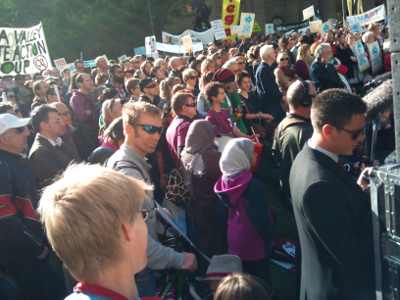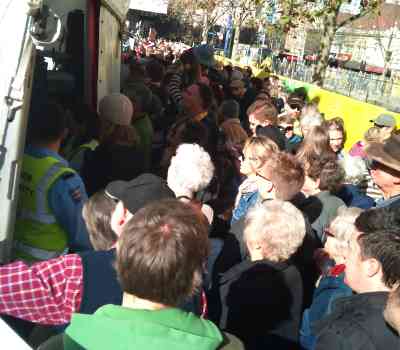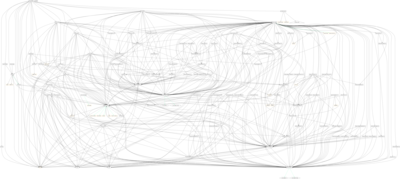Richard Hartmann: Motherland's bosom
I read a translated poem about Russia being "the Motherland" and
its vast bosom years ago. Having driven through a significant part
of it, I can agree on the "vast" part...
Also, as I am on a train and without access to the Internet, I
will refrain from linking to a lot of pages; sorry. (Turns out I am
posting this a week later, but I will still not link to stuff now;
no time).
Russia in general
- All receipts you receive are torn before you get them; this is most likely due to the old Soviet voucher system, more on that below.
- Russia was hot with temperatures ranging from 27 to 32 degrees Celsius between Moscow and Ulan Ude.
- There aren't a lot of pedestrians bridges, but a lot of pedestrian tunnels. The sides of those tunnels are packed with tiny shops, often only two meters wide and 50-70 cm deep. Everything from stockings to candy over glasses to flowers and watches is being sold through a tiny window by some poor woman who somehow managed to get in there.
- Toilet brushes stand in water. In Germany, that's a sure sign of a really dirty toilet; in Russia, it's the thing to do. If you are lucky, there's blue cleaning stuff added to the water. If not, it will still have color. You are free to guess which.
- Queuing is war.
- Go to a counter to tell an attendant what you want; receive stub
- Go to another counter, hand over stub to another attendant, pay for what you want; receive voucher
- Go to third counter, hand over voucher; receive ticket for tower The whole thing was made even more absurd by the fact that counter one was in the middle, counter two to the right and counter three to the left. As Russians do not believe in queuing and everybody just tries to get in first, this made for a nice little exercise.
- More than a thousand kilometers without a single hill. Flat as a pan.
- The whole route is powered by electricity. No diesel engines in sight.
- Many stations are little more than a heap of smoothed gravel, bordered by some wooden planks. Some stations have obviously been built by locals and are even less well-defined.
- You can see people in the middle of nowhere, walking along the railway tracks. At first this seemed counter-intuitive, but most if not all roads out there are dirt tracks. As there seems to be standing water across a third of Russia, this dirt is turned into mud. After walking maybe twenty meters across a parking lot, I had to scrape a heavy, thick cake of black earth from my soles. The railway is the only functioning footpath those people have. Many people even build shoddy bridges towards the tracks from their homes, obviously preferring to walk along the tracks over walking through the village.
- Railway crossings along the Trans-Siberian route, no matter how tiny, have a small cabin beside them. While the train passes, there's one guy or gal standing in said cabin, holding a yellow stick vertically out towards the train. Sometimes, you have not seen any living thing, other than birch trees, for twenty minutes and there, in the middle of nowhere right beside a dirt track, there's someone holding a stick out towards the train. Weird.
- Railway crossings of paved roads will always have two steel plates coming out of the ground, angled towards oncoming traffic on each side. This may not stop a heavy truck at full speed, but a car will disintegrate on these barriers without touching a passing train.
- The railways is important for Russia. Two parallel tracks cut across the whole country, transporting everything back and forth. Where "everything" means mostly coal and birch wood, I guess.
- All freight trains are usually 70 tanker waggons or 100 box waggons long, but you see the odd 100 tanker waggons, as well. You have more than enough time and opportunity to count them and then some.
- There are supposedly women at every station, selling what they cook at home. Unfortunately, this was only true for two stations. The things we did manage to get were very nice; I do wonder why anyone would offer (or buy) cooked and peeled potatoes, though.
- Every waggon has its own hot-water stove. They are powered by coal. Yep, you have a coal fire burning in every single waggon on the Trans-Siberian.
- Birch trees.
- Lots of burnt underwood, presumably to prevent larger fires.
- Birch trees.
- Sticky, stuffy, 30+ degree waggon with windows that could be opened but which were locked (this is why I always carry a Swisstool with me).
- Birch trees.
- Diesel-powered trains.
- Single track most of the time with frequent stops to let other trains pass.
- Distinctively less developed cities, stations, streets, and other infrastructure along the road.
- 32+ degrees in our waggon.
- The train attendant was extremely unfriendly and just generally
miserable even by Russian standards.
- No toilet paper or towels at all on toilets.
- While the other attendants made a point of presenting themselves well, he shuffled around in slacks all the time (not bad per se, but Russia is big on uniforms, so...)
- He took all our tickets and stubs (including the ones not from this part of the journey) and kept them without comment. After we asked for them several times, he barked at us that we would get them back before Ulan Bator. Why? No idea...
- He refused to let us exit the train during the very few stops. We were unable to exit through other waggons as the connecting door was locked. Being stuck in a train sucks.
- Border and customs took NINE HOURS!!! Stuck in blistering heat without a breeze, without access to a toilet, just waiting for bureaucracy to go its way. I checked all doors, we were locked into said waggon and there were no 'break glass to leave in emergency' windows. Especially nice as there's a coal fire burning in the hot-water stove and the whole train is plastered with warning signs about fire and what to do. In our case, presumably, burn to death; preferably without disturbing the attendant.
- The Russian stamp for entering Russia (by plane) has a plane on it, the departure one a train.
- The Russian side of the border is built like a fortress. There are several towers and bridges over the rails so trains can be checked from above, and reinforced holes dug into the ground in which soldiers stand and check the train from below.





 Most probably haven't noticed yet but I finished the
Most probably haven't noticed yet but I finished the 
 There is a reason it's called experimental isn't there?
In
There is a reason it's called experimental isn't there?
In  Dear lazyweb: I am in search of a mailing list for discussion on
matters related to digital identity and privacy in the information
age. Unfortunately, my (limited) searching has not unveiled
results, mostly because many mailing lists have privacy
agreements or somesuch, polluting the results with pointers to
those.
If you know such a list, or you don t but you are interested in
the topic, don t hesitate to
Dear lazyweb: I am in search of a mailing list for discussion on
matters related to digital identity and privacy in the information
age. Unfortunately, my (limited) searching has not unveiled
results, mostly because many mailing lists have privacy
agreements or somesuch, polluting the results with pointers to
those.
If you know such a list, or you don t but you are interested in
the topic, don t hesitate to  A few weeks ago I was trying to get GRUB2 for PowerPC back to work on my
PowerBook G4 15", and had some problems getting OF doing the right thing.
Not being an OF expert at all, I found myself making things a bit worse,
ending up with an unbootable laptop and, what a classic, unable to boot my
old rescue CD to get yaboot back in its place.
So I googled a bit and ended up deciding that, given the boot parametres
and some other stuff like the system's clock were doing strange stuff,
A few weeks ago I was trying to get GRUB2 for PowerPC back to work on my
PowerBook G4 15", and had some problems getting OF doing the right thing.
Not being an OF expert at all, I found myself making things a bit worse,
ending up with an unbootable laptop and, what a classic, unable to boot my
old rescue CD to get yaboot back in its place.
So I googled a bit and ended up deciding that, given the boot parametres
and some other stuff like the system's clock were doing strange stuff,

 Every now and then, people ask me why Debian? Why, among so many projects to choose from, I first liked, then got into, and finally I got committed into Debian, and not anything else?
Of course, one of the main points back in 2000-2001 when I started using it, and still to this very day is a strong identification with the ideological side. Yes, I am a strong Free Software believer, and Debian is what best suites my ideology.
Still, I did not only get into Debian because of this And I was reminded about this by an article in this month's
Every now and then, people ask me why Debian? Why, among so many projects to choose from, I first liked, then got into, and finally I got committed into Debian, and not anything else?
Of course, one of the main points back in 2000-2001 when I started using it, and still to this very day is a strong identification with the ideological side. Yes, I am a strong Free Software believer, and Debian is what best suites my ideology.
Still, I did not only get into Debian because of this And I was reminded about this by an article in this month's 
 About one hour ago we have finished the first
About one hour ago we have finished the first 
 during the ongoing avalanche of posts on Planet and on Debian mailing lists where you ask everyone to be friendly and considerate, you have so far:
during the ongoing avalanche of posts on Planet and on Debian mailing lists where you ask everyone to be friendly and considerate, you have so far:

